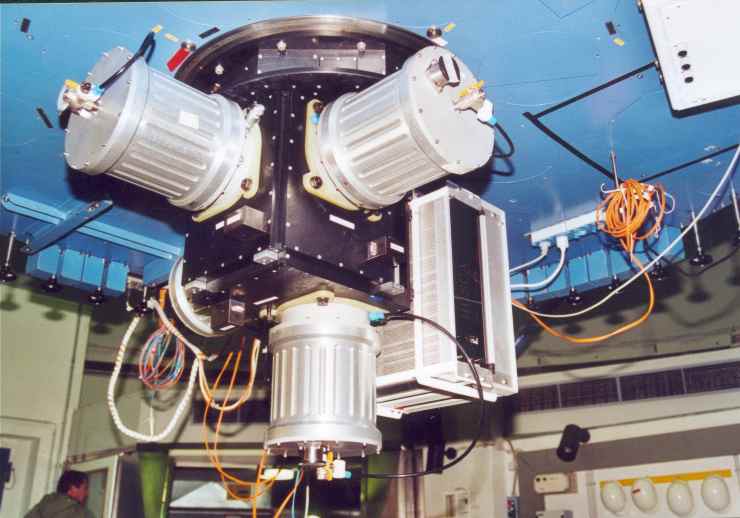 |
|
|
(February, 2001)
The dichroic beam splitters are made of plano-parallel glass plates operating at an angle of 45 degree. This causes astigmatism in the converging beam. An opto-mechanical layout was therefore choosen which cancels the astigmatism (to the greatest part) by the introduction of another plano-parallel glass plate of suitable orientation into the optical train. TEST a telescope/star simulator (f/8) has been build to verify the imaging quality of the optical setup and to prove the promising results of the optical design calculations.
By Easter 2001 BUSCA, the 64 Megapixel Bonn University Simultaneous Camera, will undergo the official commissioning procedure at Calar Alto. From then on it will be available for the community. In April 2000 the camera had its first Calar Alto test run. A second run followed in September 2000. In September BUSCA has been tested at the 1m Cassegrain telescope of the Hoher List Observatory. At September 11 it has seen First Light.(Only few days later another new instrument (VLT/UT1/FORS) received first light from the same object. If one compares our image with the ESO image it's obvious that our stars are BIGGER!)
The number of CCD-pixels and the target telescope imply a certain similarity with the WFI (at the 2.2m MPIA/ESO telescope) but BUSCA is based on a completely different concept. The instrument is designed for simultaneous four color photometry in a 12arcmin FOV. The light is split into four wavelength bands from UV to visual IR using dichroic filters. In the four corresponding focal planes the same area of the sky is imaged onto 4Kx4K 15micron pixel CCD sensors. Additional filters are provided to define standard wavelength bands. Currently the Strömgren filter set is available.
A more detailed description
of BUSCA is given by Reif et al. (1999, have a look at the on-line
version ) and Reif et al. (2000) .
 |
|
|
The following table lists the main instrument parameters:
| Number of dichroic plates | 3 |
| Wavebands (in nm) | <430, 430 to 540, 540 to 730, >730 |
| Filter wheels | 4, with 4 positions each |
| Filter format | round, diameter = 109mm, thickness = 15mm |
| Filters available | Strömgren u,v,b,y, Bessell I (u, v not simultaneously usable) and Strömgren Hbeta (narrow and wide) |
| Detectors | 3x CCD485 Lockheed Martin, 4096 x 4096 pixels with 15mue x 15mue,
frontside devices,
1 CCD485 backside thinned (in the uv channel). This device was not yet available in 2000. |
| Number of pixels | ca. 67 Mill. (4x 16.8 Mill.), ca. 16.8 Mill. total with 2x2 binning |
| Field of view | 12 arcmin x 12 arcmin |
| Pixel size | 0.176 arcsec (0.35arcsec with 2x2 binning, standard at typical seeing conditions) |
| CCD controller | MPIA design, 4 channels maximum |
| CCD read out | four color channels simultaneously |
| Read out time | ca. 2min with 2x2 binning |
| Read out noise | 7 electrons, typical |
| Shutter: Type | "Bonn Shutter", two blade, stepper motor driven |
| Shutter: Min. exposure time | < 10ms |
| Shutter: Photometric performance | Exposure homogeneity >99% at 100ms exposure time |
| Guider FOV | 5.6 arcmin x 4.2 arcmin |
| Guider field position | fixed, 8 arcmin north of camera field center |
| Limiting magnitude (y) | 20 mag at 30 min exposure time, seeing = 1.2 arcsec |
| Data storage/format | one FITS file for each of the four CCD frames |
(If the standard 2.2m TV-guider unit were used the BUSCA image plane would be to far behind the optimum focus for the 2.2m telescope. The height of the original TV-guider unit and the long optical path through the BUSCA beam splitter unit together produce a to large back focal distance.)
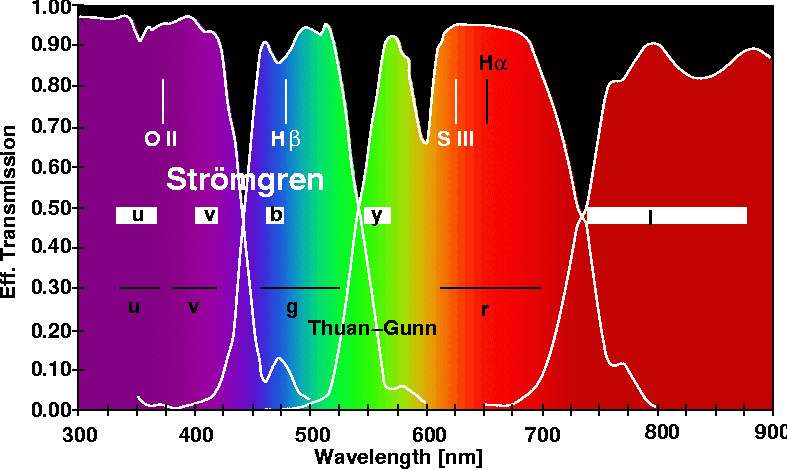 |
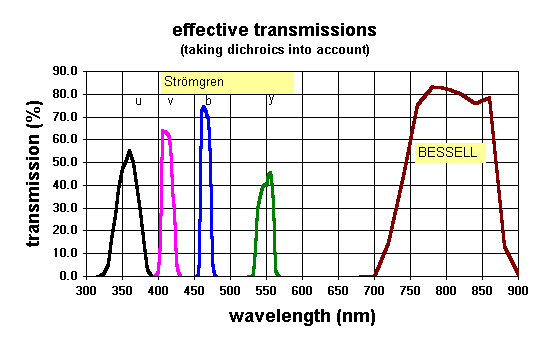 |
| The Four BUSCA wavebands. They are named - from left to right - uv, b, r, nir. Indicated are positons and widths of standard line, intermediate and broadband filters. Filters marked by white horizontal bars (u,v,b,y, Bessell I) are at present available. | Effective tansmission of the available Strömgren and broad band filters (CCD QE not included). H beta (wide), H beta (narrow), are also available. |
 |
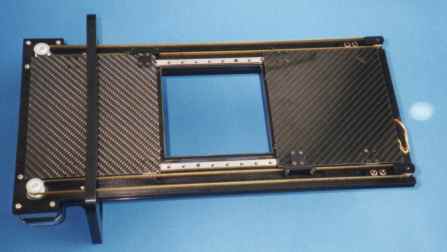 |
| The shutter is a removable drawer-like unit. The flat part is inside the instrument housing (the cube) and the left hand side box (with motors/encoders) outside. | Shutter interiors: Visible are the two carbon fiber blades, the linear ball bearing rails and the toothed belts. |
In order to test the exposure unifomity flat fields were taken with
short (0.1sec) and long (10sec) exposure times. The comparison shows that
the remaining non-uniformities are much less than 1% across the full 4K
CCD along the direction of the shutter movement. This is consistent with
independent timing measurements: We find that the scatter in exposure time
across the shutter aperture is less than 1msec peak to peak.
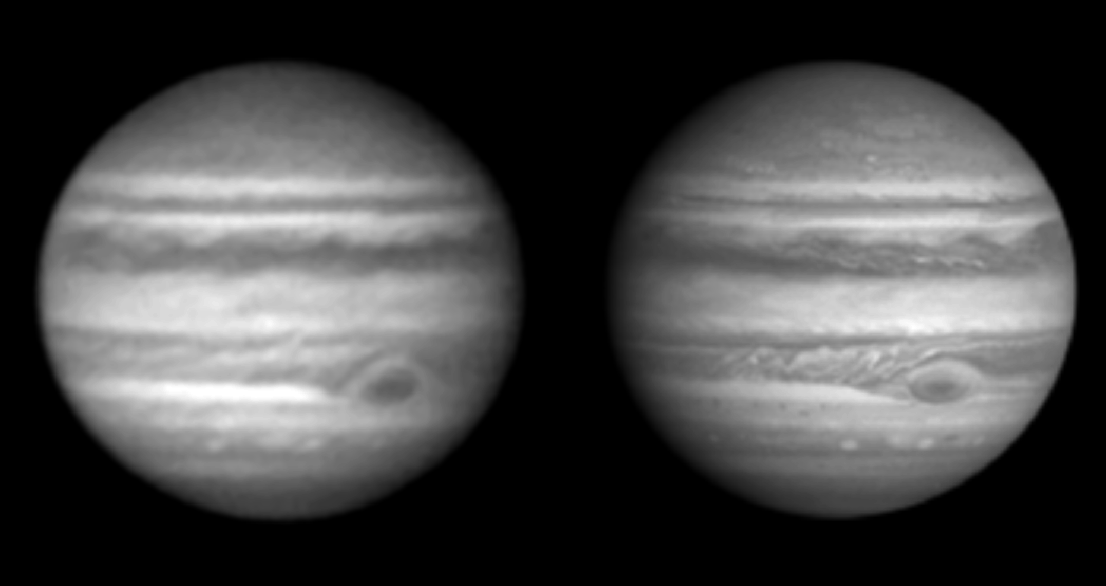 |
|
|
To take advantage of those perfect seeing conditions the CCD's have
to be read out unbinned with full resolution (0.176arcsec per pixel). The
image of the globular cluster M13 is another example. Stellar images in
the four corners show consistently PSF's with a FWHM of 0.81arcsec.
The radial PSF diagrams above show some residual scatter which is due
a weak PSF ellipticity (0.08). This ellipticity was found all over the
image and is mainly east-west oriented. After some investigation it was
realized that it is most probably caused by a small east-west oscillation
of the telescope structure. This is a known effect with a pretty small
amplitude of about 0.5arcsec which becomes detectable only in really good
seeing conditions.
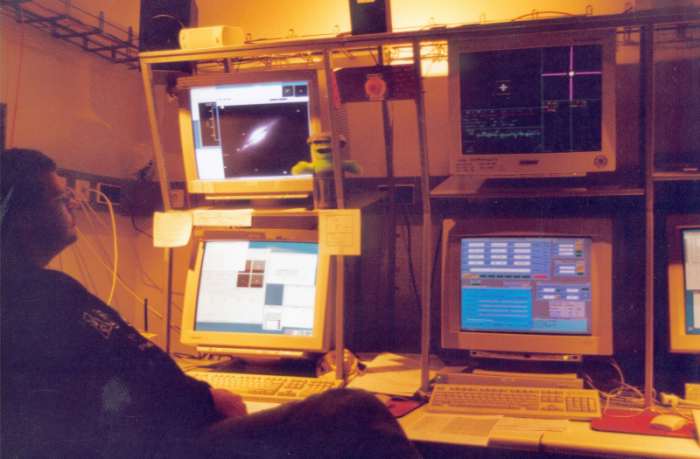 |
| The observers environment: On the lower left hand monitor the Busca GUI with its characteristic 4 thumbnail windows for real time data display (active during data acquisition). |
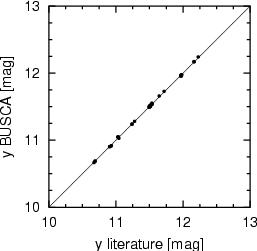 |
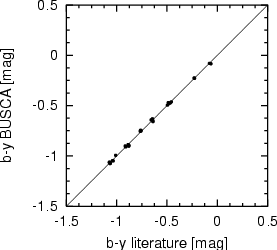 |
| Magnitude and color calibration relations. Residuals with respect to a slope of 1.0 show a scatter of 0.010mag for y and 0.012mag for b-y. |
Based on this calibration we derive the CMD shown below. To reduce the
influence of the field stars around M71 only stars within a distance of
2.5arcmin around the cluster center were included.
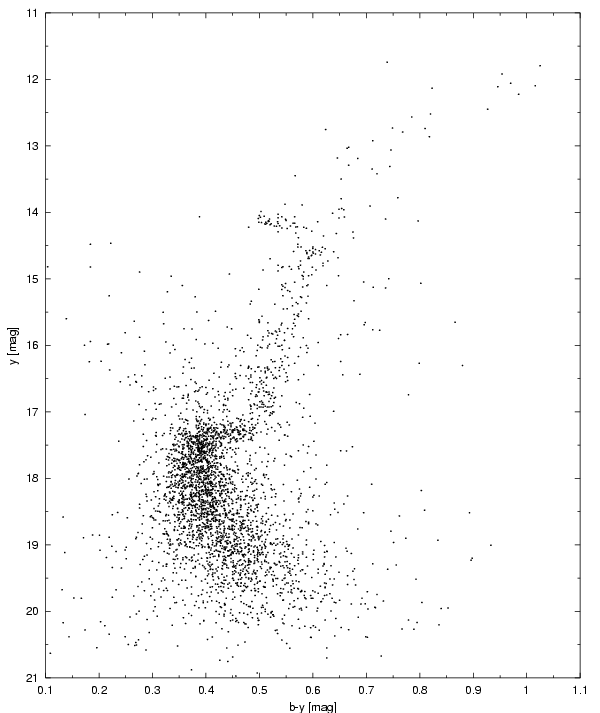 |
| CMD of the low latitude globular cluster M71 (l = 56 deg, b = -5 deg,
E(B-V) = 0.7, varying over the cluster). Exposure time was 30 minutes.
The horizontal branch as well as the turn over point are well defined.
The diagram is not yet corrected for the influence of field stars. |
From this diagram a limiting y-magnitude of about 20 mag can be derived (exposure time: 30min, photometric error: 0.05mag). The CMD shows a well defined red horizontal branch and turn off point. Some of the scatter in the diagram may be due to differential reddening, although this has to be investigated in detail. The red giant branch is not well populated as already mentioned by Geffert et al. (2000).
Including the "v" frames in our analysis we will investigate metallicities
of red giants. Based on the m1 vs. b-y diagram metallicities will be derived
using the relation discussed by Hilker (2000). Similar studies of M22 and
M55 by Richter et al. (1999) show a large scatter in metallicity which
can not be attributed to photometric errors only. CN variations are currently
discussed as a possible explanation.
After commissioning BUSCA will enter the pool of available instruments at Calar Alto. As the Strömgren filter set is currently the only complete set, it is to be expected that BUSCA will mainly be used for stellar work. This may change in future, as new filters become available. The use of existing filters from the observatory (if to be used simultaneously!) is limited to those with identical optical path lengths. It should also be kept in mind, that the 4K x 4K CCDs need large filters (diam.: 109mm) to avoid vignetting. But if a reduced field of view is acceptable, smaller filters could be inserted (adapter needed). A typical 2 inch filter reduces the FOV to about 6 arcmin.
The limiting magnitude in the blue, red and NIR channels can be improved by about 1 mag by replacing the thick frontside CCD's by backside thinned detectors. It should also be mentioned that the thick CCD's have a lower than standard CTE (charge transfer efficiency). This would also be improved by new detectors.
Observing time can be used more efficiently if the 4-channel CCD-controller were replaced by a faster multichannel system. This is particularly true if under good seeing conditions the corresponding imaging quality can only be achieved with an unbinned full resolution CCD read out (which takes more than 6 minutes!). When the BUSCA system was designed the 4-channel MPIA controller was the only choice. With BUSCA this controller is used at its limits.
Geffert M., Maintz G., 2000, A&AS 144, 227
Kohley R. 1998, PHD thesis, University of Bonn; Multicolor CCD-photometry of M34 under the aspect of the instrumental development of BUSCA. (download the zipped PS file (8 MB))
Perry C.L., Olsen E.H., Crawford D.L., 1987, PASP 99, 1184
Reif K., Bagschik K., de Boer K.S., Schmoll J., Müller Ph., Poschmann H., Klink G., Kohley R., Heber U., Mebold U. 1999, SPIE Vol. 3649, 109 (HTML version available)
Reif K., Poschmann H., Bagschik K., Cordes O., Harbeck D., Müller Ph., 2000, in `Optical Detectors for Astronomy', eds. P. Amico and J.W. Beletic, Kluwer Academic Publisher, 143 (download the PS (4.2 MB) or zipped PS (0.84 MB) file)
Richter P., Hilker M., Richtler T., 1999, A&A 350, 476
Schmoll J. 1997, Diploma Thesis, University of Bonn; Ein optischer Testaufbau für die Bonner Vierfarb-Simultankamera.